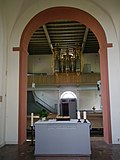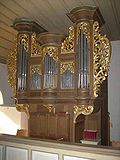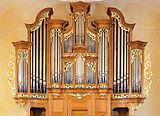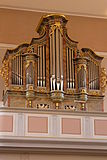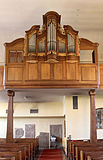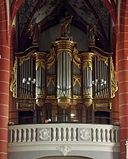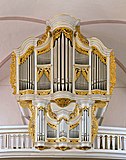Stumm (organ builder family)
The Stumm family , with their main representative Johann Michael Stumm, is one of the most famous organ building dynasties in Germany.
According to current research, over 370 organs (140 of which have largely been preserved to this day) have been built in seven generations .
Effective range
The family's roots can be found in Rhaunen in the Hunsrück . Johann Nikolaus Stumm was born there in 1669 and built an iron hammer "on the birch field" near Schauren . From there, the organ building family had a lasting impact on organ building in the Middle Rhine region over a period of almost two centuries. While the area of activity initially concentrated on the Hunsrück, it eventually extended from the Cologne area to Saarbrücken, from Luxembourg to the Odenwald. Johann Michael already received orders in Rheinhessen and in the Moselle valley from Trier to Koblenz. In the second generation, the area of activity was extended from Saarland to the right bank of the Rhine. The workshops finally had to be given up, as the modern working competition was preferred. Stumm organs can be found in Protestant and Catholic churches and abbeys, but also in princely chapels and castle churches. The electoral court of Mannheim was one of the customers. Mozart was involved in the inspection of the organ of the Trinity Church , which Stumm had built there in 1777 . Abbé Vogler gave his famous concerts on it. Allegedly Catherine II of Russia is said to have tried to persuade the Stumm to deliver an organ to St. Petersburg. A number of instruments that have now been restored or reconstructed in exemplary fashion bear witness to the high quality of the Stumm family of organ builders.
plant
The founder of the dynasty, Johann Michael Stumm , merged French, South German-Austrian and Central German influences into an independent synthesis. The selection of the best materials and the use of high-quality oak, which has been stored for 15 years, was already a guarantee of the best possible quality in the 18th century. A house organ built by the organ builder Johannes Irrlacher for the citizen of Kirner Johannes Hildenbrand (with the registers Bourdon 8 ′, Rohrflöte 4 ′, Octav 2 ′, Salicional 2 ′ repeating on c 1 to 4 ′, quint 1 1 ⁄ 3 ′ repeating on c 1 on 2 2 ⁄ 3 ′) obviously formed another inspiration for Johann Michael Stumm. This disposition formed the basis of the voices in the ancillary works of the organs he had built. The construction method developed by Johann Michael Stumm remained formative for the entire company and was passed on through the generations. In the second generation with Johann Philipp and Johann Heinrich, the company flourished in terms of quality, distribution and reputation. The later generations built on the good reputation and continued the building principles conservatively. Right up to the end, the instruments are characterized by high quality workmanship and characteristic intonation .
In terms of sound, the warm, singing, lightly bowing principals , which in the first generations of the Hauptwerk were expanded into full principal choirs (8 ′, 4 ′, 2 2 ⁄ 3 ′, 2 ′, 1 3 ⁄ 5 ′, 3- or 4-fold mixture on a 1 'basis). All aliquot registers are also built as principals and are voiced accordingly. The flute chorus is carried smoky Gedacktregister in and hochgebänkte Cornet, the reeds in French tradition are strongly voiced (trumpet, Krummhorn, Vox humana , Vox angelica 2 ', and pedal in Posaunbaß). There are also string registers and solo voices such as Viol di Gamb 8 ′, Quintathön 8 ′ or the Flaut travers (treble) made from pear tree and, in the first generations, a peculiar solicinal 2 ′ (bass C – h °) repeating 4 ′ (treble from c 1 ). The individual registers are characterized by a great fusion of sounds and are not particularly prominent in favor of the tonal unity. The Gedackt is almost always referred to as "Hohlpfeif". Different flute and tongue registers are divided into bass / treble; the flaut traverse occurs only in the treble area. Especially in the later works there is an increase in the loop division in single-manual works . From the fifth generation, more fundamental registers were used, the number of aliquot registers and reeds were reduced and the intonation was generally softer. Nonetheless, the sound pattern remains tied to the late Baroque, so that silent organs were considered old-fashioned from the second half of the 19th century, although from 1870 cone shops were built and in some cases double labia or overblowing registers were used . However, the correspondence still preserved from the last time also shows that the then emerging experts branded the organ builders Stumm as conservative and backward, in order to give other, favored organ builders of the time a chance.
The architectural construction and the sound conception of the basic type have seen little change over the generations and have only been modified according to the spatial conditions and the size of the instruments. In detail, however, 30 different regional prospectus types can be distinguished, of which around half can be traced back to Stumm and, above all, in the second generation, and in isolated cases developed up to 1830. Some of them later served as models for other organ builders. While Johann Michael preferred a back positive for larger instruments, his descendants integrated the second manual as a lower positive in the parapet under the Hauptwerk case. Johann Michael Stumm also came up with the idea of building an echo mechanism in addition to the Rückpositiv , which was then placed in the lower case of the main organ, additionally enclosed in a separate box. The invention of the side organ is said to go back to the organ builder family Stumm. According to the Middle Rhine tradition, the range of the pedal is often only one or one and a half octaves (Cd 0 or C – g 0 ). The already mentioned cone drawer was used at the end of the fifth generation; From that time on, the design of the prospectus was influenced by neo-Gothic or neo-Romanesque styles and, as was customary at the time, often specified by an architect or church builder.
Famous representatives
In addition to the aforementioned representatives, other family members also worked.
First generation
Life
Johann Michael Stumm (born April 10, 1683 in Sulzbach / Hunsrück, † April 22, 1747 in Sulzbach) was born as the son of Johann Christian Stumm. For generations family members worked as blacksmiths or in the metallurgical industry . His brother Johann Nikolaus was the founder of the mining entrepreneur family Stumm . Johann Michael initially trained as a goldsmith from around 1696 to 1701 . He married Eulalia Gertraude Laux in 1706 in Sulzbach, where he settled in 1714. The two were given two daughters and six sons. After winning a small house organ in a lottery that he had to fix, he turned to organ building. It is unclear with whom he spent his apprenticeship as an organ builder and who significantly influenced him. Jacob Irrlacher, Johann Hoffmann, Johann Jakob Dahm and Otto Reinhard Mezenius, for example, come into question, none of whom has been proven to be Stumms' teacher. He is referred to as a master for the first time in the contract with Münstermaifeld .
stylistics
The organ structure by Johann Michaels showed French influences in its disposition . This is particularly characterized by the division into main work and Rückpositiv. The design of the prospectus is characterized by three round towers, which goes back to Rhenish influence, while the typical Main Franconian harp fields only encountered the first new organs in Münstermaifeld and Rhaunen. The second generation designs ever more sweeping prospect fronts, e.g. B. reach their climax with the organs in Amorbach , Saarbrücken or Frankfurt .
List of works
The size of the instruments is indicated in the fifth column by the number of manuals and the number of sounding registers in the sixth column. A capital “P” stands for an independent pedal, a lowercase “p” for an attached pedal. Italics indicate that the organ in question is no longer available or that only the prospectus has been preserved.
| year | place | building | image | Manuals | register | Remarks |
|---|---|---|---|---|---|---|
| 1717 | Kirchberg | Michaelskirche | I / P | 14th | First organ built by Johann Michael Stumm. According to the contract, based on Principal 4 ′, lateral harp fields for the Principal Bass 8 ′ pedal register, housing probably closely related to the organ in Rhaunen. On this organ, Johann Michael Stumm experimented with the open bass flute 8 ′ made of wood. Not preserved, replaced from 1753–1754 by a conversion / new building by RB Nollet , whose prospectus has been preserved . | |
| 1722 | Münstermaifeld | Collegiate Church of St. Martin and St. Severus | II / P | 22nd | originally with Rückpositiv; Replaced in 1864 by a new building by Ludwig Hünd; Prospectus pipes and case front received from Stumm | |
| 1723 | Rhaunen | Ev. church | I / P | 13 | Backhanded; Various modifications in the 19th and early 20th centuries, some by Gustav Stumm. Loss of the fifth, third, trumpet and vox humana registers. In 1934, extensive extension conversion and technical new construction by Oberlinger on II / P / 17 while retaining the upper case, the front of the lower case and a large part of the pipework. Wind chest from Oberlinger used for another new organ. 1977/78 Restoration and technical reconstruction of the performance and stop action by Klais. Return of the original manual drawer, reconstruction of the rear wall of the lower case, supplementation of missing items in the original registers, reconstruction of the trumpet and vox humana registers. There is a considerable number of original pipes. | |
| around 1723 | Hamlet near Monzingen | Parish Church of the Conception of Mary | I / p | 7th | Originally back organ with attached pedal. Components of the original play system are still preserved on the back of the case. Presumably revised by the second generation, the play system moved to the side and the third third changed to a covered flute. Two stops exchanged in the early 20th century (removal of mixture and cromhorn / trumpet, insertion of violin principal and salicional), 1917 confiscation of the front pipes. 1992 restoration of the original disposition by Klais; some old registers preserved (in addition to the largely preserved registers Hohlpfeif 8 ′, Flöt 4 ′, Quint 2 2 ⁄ 3 ′, Octav 2 ′, the inner pipes of the Principal have been preserved), reconstruction of the registers Principal 4 ′, Mixtur III 1 ′ and Cromhorn / Trumpet 8 ′ based on original Stumm models. Maintain side layout. Attached pedal, circumference C, D – c °, probably the oldest originally preserved Stumm pedal keyboard. | |
| around 1727 | Hergenfeld | Catholic Church | I / P | 11 | Originally behind the scenes, built for Stromberg, cath. Local community; Relocated to Hergenfeld by Johann Schlaad in 1863, with a new lower case and new side play equipment. In the 19th and early 20th centuries, the principal 4 ′, fifth 2 2 ⁄ 3 ′ and third 1 3 ⁄ 5 ′ registers were lost, salicional 8 ′ and aeoline 8 ′ were added instead. Eight registers completely preserved, including a. Trumpet 8 ′ and Discant Flute 8 ′ | |
| 1728 | Cards | St. Castor | III / P | 29 | First three-manual organ Stumms (with echo mechanism); 1933–1935 remodeling by Klais; 1973 completion of the reconstruction by Klais; 7 registers completely and 7 partially preserved; today III / P / 32 | |
| 1728 | Schwarzrheindorf | St. Mary and Clement | II / P | 25th | Originally built for the Franciscan Church in Koblenz, sold to Mayen, St. Clemens around 1803, to Nachtsheim in 1875 and to Schwarzrheindorf in 1936, where it was extensively rebuilt in neo-baroque style; 1966–1968 restoration by Klais and again in 2007 after mold attack; received some registers | |
| around 1735 | Traben-Trarbach | Ev. Traben Church (Peterskirche) | I / P | 12 | 1880 reconstruction and 1957 expansion by Oberlinger (II / P / 23), in 1984 further expansion by Gustav Cartellieri to three manuals; only received housing from Stumm | |
| 1737 | Hottenbach | Evangelical Church of Hottenbach | 1737 new building by Johann Michael Stumm, 1782 rebuilding by Johann Nikolaus Stumm or Johann Friedrich Stumm, radically rebuilt by Gustav Stumm in 1904; The upper case of the first organ with its round towers characteristic of Johann Michael Stumm and the rich acanthus carving is still preserved. Major parts of the registers Hohlpfeif, Principal, Flöt, Quint, Octav and Mixtur can also be traced back to Johann Michael Stumm. | |||
| 1737 | Alzey | Little church |
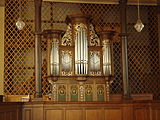
|
II / P | 19th | 1882 Karl Landolt added two more registers to the pedal mechanism; 1950 Conversions by Förster & Nicolaus, loss of the original Gamba 8´. 1998 restoration by the same company (today II / P / 21); largely preserved. After restoration, the disposition does not correspond to the original disposition (instead of Salicional 4 ′ today Salicional 8 ′ Treble, instead of Krummhorn 8 ′ Treble in the echo today trumpet 8 ′ Treble). |
| 1735-1738 | Leutesdorf | St. Laurence | III / P | 28 | Largely preserved | |
| 1738 | Mühlheim an der Eis | Castle Church | II / P | 24 | In addition to the Kirchheim-Bolanden organ, it is the most important monument organ in the Palatinate. Largely preserved (with the exception of the manual keyboards and the tongues Trompet 8 ′, Cromhorn / Trompet 8 ′, Vox humana 8 ′). As the only one of all organs built by Johann Michael Stumm, this organ has a Gemshorn 8 ′ in the main work. | |
| 1739 | Armsheim | To the holy blood of Christ | II / P | 20th | Largely preserved | |
| 1738-1740 | Heimbach-Weis | Parish Church of St. Margaretha | III / P | 37 | Originally built for Rommersdorf Abbey ; 1809 transfer to secularization | |
| 1739-1740 | Bad Sobernheim | St. Matthias | II / P | 25th | 1878 reconstruction by Johann Schlaad; 1972 renovation and pedal expansion by Paul Ott to II / P / 30; 20 stops of Stumm preserved in whole or in part; restored and reconstructed 2003–2005 by Rainer Müller, Merxheim | |
| 1739 | Spa bridges | Assumption Day | II / P | 26th | Originally a back-playing parapet organ with a sub-positive as an echo. 1896 extensive reconstruction and technical new building by Johann Stockhausen; 15 registers preserved in whole or in part; restored and technically reconstructed 1988 Gebr. Oberlinger , re-intonation and sound reconstruction 2011 Raab-Plenz organ building , Bad Kreuznach | |
| 1741 | Waldlaubersheim | Martinskirche | I / P | 14th | Largely preserved. In the original, the organ had only one attached pedal, but the register Grosshohlpfeif 16 'in the manual. Schlaad added an independent pedal system in the 19th century. | |
| 1743 or 1752 | Lötzbeuren | Ev. church | I / P | 9 | Largely preserved | |
| around 1743 | Finkenbach-Gersweiler | Fortified church | I / P | 10 | 1919 extension conversion by Walcker (II / P / 15); 1962 new building by Oberlinger; only got a prospectus from Stumm | |
| 1743-1745 | Kirchheimbolanden | Paulskirche | III / P | 45 | According to the number of registers, the largest surviving organ in the Stumm workshop, built as a three-manual organ with main work, sub-positive, echo and pedal towers. In 1778 Wolfgang Amadeus Mozart played the organ that was later named after him. It is one of the last original baroque organs by Johann Michael Stumm. During a renovation around 1971 by Gebr. Oberlinger Orgelbau, removal of the original play system and the entire mechanism, manual and pedal extensions, insertion of a cymbal in the echo, extensive extension of the pedal disposition. The original gaming table is now on display in the royal box. | |
| 1746 | Sulzbach | Ev. church | II / P | 23 | The pipe material was probably looted by French soldiers around 1800; 1820 restoration through mute, with the original disposition of the upper positive moderately changed: instead of salicional 8 ′ treble now flaut travers 8 ′ treble, instead of fifth 1 1 ⁄ 3 ′ repeating on c 1 2 2 ⁄ 3 ′ now fifth 2 2 ⁄ 3 ′ continuously, instead of Cromhorn / Trompet 8 ′ now Krummhorn 8 ′. Conversions around 1934 by Oberlinger, restored 1980–1982 by Klais, Bonn. A free loop in the main work is occupied by Clarin 4 ′ (bass). Reconstruction of the chromatic pedal box behind the organ with the registers Subbass 16 ', Octavbass 8' and Quintbass 6 '. |
Second generation
Johann Philipp and Johann Heinrich Stumm are proven to have worked in their father's workshop from 1739 onwards, which they take over when their father dies in 1747. Her brother Johann Friedrich (I.) Stumm (†) appears as a further employee. The fourth brother Johann Nikolaus (1706–1779) married in Kastellaun , where he founded his own company, which was only continued by his son Heinrich Ernst (1756–1802). The Kastellauner line created organ works between 1748 and 1779.
The Sulzbach-based company reached its heyday in terms of quality and scope in the second generation with the two brothers:
- Johann Philipp Stumm (born August 24, 1705 in Sulzbach; † December 18, 1776 in Sulzbach), son of Johann Michael
- Johann Heinrich Stumm (born April 24, 1715? In Sulzbach; † August 23, 1788 in Sulzbach), son of Johann Michael
stylistics
Characteristic for the organ buildings of the second generation were above all the shifting of the console to the side and the use of the back positive as a lower or upper positive. The brothers developed a large number of typical landscape prospectuses.
List of works
| year | place | building | image | Manuals | register | Remarks |
|---|---|---|---|---|---|---|
| 1744 | Oberlahnstein | St. Martin |
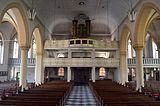
|
II / P | 22nd | Largely preserved |
| 1745 | Ensheim | Ev. church | I / P | 9 | 1984 restoration by Förster & Nicolaus; Most of the registers preserved | |
| 1748 | Westhofen | Ev. church | I / P | 15th | Johann Nikolaus Stumm, parapet organ | |
| around 1749 | Koblenz | St. Maximin |

|
I / P | 8th | Prospectus received |
| 1748-1750 | Trarbach | Ev. church | II / P | 22nd | 1935 by Steinmeyer effective extension conversion (II / P / 27); 2008–2010 restoration by Rainer Müller | |
| 1750 | Heimersheim | Mauritius Church | I / p | 9 | 1999 restoration by Förster & Nicolaus; Except for 2 registers completely preserved | |
| 1751-1752 | Raversbeuren | Ev. church | I / P | 10 | In 1892, it was interveningly rescheduled; in 1972, Oberlinger renewed the original planning | |
| 1753 | Simmern / Hunsrück | St. Joseph | After various revisions in the 19th century, it was rebuilt in 1895 by Heinrich Voltmann ; Remnants of the Stumm prospectus have been preserved | |||
| 1753-1755 | Ingelheim | Castle Church |

|
Johann Philipp and Johann Heinrich Stumm; after various renovations, new building by Walcker in 1913 and by Emanuel Kemper in 1963 ; Prospectus received . Prospectus of the sub-positive detached from the housing and moved to the northern area of the gallery as the prospectus of today's auxiliary work. | ||
| 1755 | Osthofen | Mountain church | II / P | 22nd | Johann Philipp and Johann Heinrich Stumm; Treaty of 1748, 1752 additional positive agreed during construction, completed in 1755; behind the prospectus received 1903 new building through link | |
| 1752-1756 | Bechtolsheim | Simultankirche organ article |
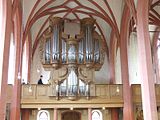
|
II / P | 28 | 1899 reconstruction by Heinrich Bechstein ; Much of Mute received; 2014/15 restoration by Förster & Nicolaus Orgelbau |
| 1757 | trier | Welschnonnen Church | I / p | 11 | 1865 remodeling by the Breidenfeld company; 1957 extension conversion by Oberlinger to II / P / 23; today the oldest organ in Trier and the only preserved Stumm organ in Trier, | |
| 1758 | Dannenfels | Ev. church | II / P | 12 | largely preserved | |
| 1758-1759 | Durlach | Town church Durlach | III / P | 39 | New buildings in 1895/96 by Heinrich Voit , 1968 by Oberlinger and 1999 by Goll ; Prospectus with 3 principal registers received from Stumm | |
| 1759 | Wörrstadt | Laurentiuskirche | II / P | 30th | 1842 reorganization by Bernhard Dreymann ; later further changes; large part of Stumm has been restored by Gebr. Oberlinger , 2011 cleaning and re-tuning by Rainer Müller, Merxheim | |
| 1754-1761 | Enkirch | Ev. church | II / P | 26th | With the participation of Theodor Claus, Cochem; 1905 renovated by Gustav Stumm and rearranged somewhat; 1962 Return to the original planning by Oberlinger | |
| 1761 | Mannheim | Konkordienkirche | Destroyed in a fire in the church in 1795 | |||
| 1762 | Mettenheim (Rheinhessen) | Ev. church | II / P | 23 | Later rescheduling by H. Bechstein; 1985 restoration by Förster & Nicolaus | |
| around 1764 | Bornheim (Rheinhessen) | Ev. church | I / P | 9 | Largely preserved (except for 2 registers) | |
| 1764 or 1766 | Freimersheim (Rheinhessen) | Protestant church | I / P | 9 | Trumpet 8 ′ is missing, otherwise original, almost identical to the sister instrument built at the same time in Bornheim | |
| 1766 | Wetzlar | Franciscan Church | II / P | 30th | Donated to Trier Cathedral in 1830 ; In spite of the suggestions for modification of the silent, it was not installed there. | |
| 1764-1768 | Meisenheim | Castle Church | II / P | 29 | 1886/87 rearrangement by Meyer, Herford; 1968 extensive return to the original disposition by Oberlinger; 1994 restoration by Förster & Nicolaus; largely preserved | |
| 1768-1769 | Roth (Rhein-Hunsrück District) | Ev. church | I / P | about 10 | First construction on the gallery; 1783 major repairs by Friedrich Carl Stumm; after constantly necessary repairs (the organ was partially exposed to the weather through the sound holes in the church tower) it was housed in the enlarged choir during the church renovation in 1852; 1892 rearrangement and 1929 new plant by Oberlinger; with the major church renovation in 1964, he was moved back to the gallery. Only the prospectus from Stumm has survived. | |
| 1769 | Rheinberg | St. Peter | II / P | 21st | Originally built for another, unknown church; 2009 new building in Weimbs ; Prospectus received | |
| 1770 | Worms-Pfeddersheim | Simultankirche (Protestant part) | II / P | 25th | 1913 new Walcker organ behind the Stumm prospectus | |
| 1769-1771 | Bärstadt | Martinskirche | II / P | 23 | Largely preserved; 2015 restoration by Förster & Nicolaus | |
| 1772 | Hillesheim | St. Martin | I / P | 14th | 1872 extension conversion by Gebr. Müller (today II / P / 28); 6 registers received from mute | |
| 1773 | Gau-Odernheim | Simultaneous church | II / P | 22nd | 2001 restoration by Förster & Nicolaus; 14 registers preserved | |
| 1773 | Mainz | Augustinian Church |

|
II / P | 35 | Completed in 1773, original conception as a church organ of the Augustinian monastery. The structure of the work is divided into the main work case in the north, the pedal case in the south and the positive crown by leaving the west window open. In the 19th and early 20th centuries, moderate changes due to the loss of the pipe works, the gamba of the main work and the mixture of the positive and the play structure. 1991 restoration by Förster & Nicolaus; Reconstruction of the pipe works, the gamba and the mixture of the positive, largely preserved. Due to the high proportion of original pipework and the number of registers, it is one of the most important preserved of all Stumm organs. |
| 1762-1775 | Saarbrücken | Ludwig Church |
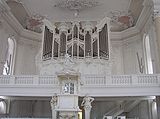
|
III / P | 37 | Destroyed by a bombing raid in 1944, in 1982 a new Beckerath building (III / P / 49) behind a case reconstructed by Orgelbau Kuhn |
| around 1775 | Framersheim | Ev. church | I / P | 18th | 1981 restoration by Förster & Nicolaus; largely preserved | |
| 1776 | Irmenach | Ev. church |

|
I / P | 13 | 1965 change by Oberlinger (reed register replaced by Principal 8 ′ and Äoline 8 ′, also extended pedal range to C – d 1 ); 1996 Restoration by Gustav Cartellieri (new vox humana and trumpet, pedal circumference remained unchanged). Disposition: Manual (divided: bass C – h, treble c – c 3 ): Gedackt 8 ′ (B / D), Salicional 8 ′ (B / D), transverse flute 8 ′ (D), Kleingedackt 4 ′, principal 4 ′ , Octave 2 ′, fifth 2 2 ⁄ 3 ′, third 1 3 ⁄ 5 ′, mixture III, trumpet 8 ′ (B / D), vox humana 8 ′ (B / D); Pedal : sub bass 16 ′, octave bass 8 ′ |
| 1773-1778 | Bendorf-Sayn | Sayn Abbey | II / P | 24 | 1996/1997 Restoration of the lower case of the organ , which was set back in the meantime, by Klais , who almost reconstructed the original condition including the disposition | |
| 1778 | Frankfurt am Main | Katharinenkirche | III / P | 41 | Johann Phillip and Johann Heinrich Stumm; Mozart gave concerts in the church in 1790; Replaced in 1833 by a new building by Walcker and in 1909 by Steinmeyer behind the old prospectus; Destroyed in 1944 | |
| 1780 | Schauren (near Idar-Oberstein) | Ev. church | I / P | 13 | 1969 Reconstruction of the lost registers by Oberlinger | |
| 1774-1782 | Amorbach | Former abbey church |

|
IV / P | 66 | One of the largest surviving baroque organs, of international importance; 5116 pipes |
| 1776-1782 | Simmern / Hunsrück | Stephanskirche | II / P | 27 | Johann Philipp and Johann Heinrich; 1934/35 renovation by Steinmeyer on II / P / 32; largely preserved; restored and reconstructed 2007–2009 by Rainer Müller, Merxheim |
Third generation
The third generation of the family did not differ significantly in form and style from the work of the previous generation. After ten years of transition with the second generation, she became self-employed in 1782/83. The area of activity on the right bank of the Rhine was expanded. Their representatives were the cousins:
- Johann Michael (II.) Stumm (1732–?), Son of Johann Philipp
- (Johann) Philipp Stumm (born October 7, 1734 in Sulzbach; † June 13, 1814 in Sulzbach), son of Johann Philipp
- Friedrich Carl Stumm (born August 9, 1744 in Sulzbach; † December 4, 1823 in Sulzbach), son of Johann Friedrich (I.)
- (Johannes) Franz Stumm (born March 12, 1748 in Sulzbach; † April 22, 1826 in Sulzbach), son of Johann Heinrich
List of works
| year | place | building | image | Manuals | register | Remarks |
|---|---|---|---|---|---|---|
| 1767 | Steinbach (Taunus) | St. George's Church | I / P | 13 | Johann Michael (II.) Mute; originally built for jumpers ; Sold to Steinbach in 1834; restoration by Förster & Nicolaus in 2011; largely preserved | |
| 1772 | Mr. Stein | Castle Church | I / P | 15th | 1959 repair by Oberlinger; currently seven registers vacant; 2000 restored and reconstructed by Rainer Müller, Merxheim | |
| 1778 | Mauchenheim | Ev. church | I / P | 13 | Philipp and Franz Stumm; largely preserved | |
| 1774-1779 | Gensingen | Ev. church | I / P | 16 | Philipp and Franz Stumm; In 1974 lost registers reconstructed by Schmid ; Restored in 2000 by Förster & Nicolaus ; largely preserved | |
| 1770-1780 | Sötern | Ev. church | I / P | 12 | Rebuilt in 1930 by Oberlinger, 1975 by Cartellieri; half received | |
| around 1780 | Hasselbach (Taunus) | St. Margaretha |
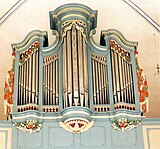
|
I / P | 17th | Side parapet organ ; partially preserved |
| 1781-1782 | St. Wendel | Wendalinus basilica | III / P | Friedrich Carl Stumm. In 1936 the organist W. Endres judged: "The old organ from 1781, the renewal of which was not worthwhile, showed an elegant, vocal intonation in individual registers and a surprising euphoria in the entire work despite its damage." / Received in 1934. | ||
| 1782 | Hochstetten-Dhaun | St. Johannisberg Collegiate Church | I / P | Originally built for Laubach; Sold and transferred in 1856 | ||
| 1780-1783 | Idstein | Union Church |

|
II / P | 24 | Johann Heinrich and Franz Stumm; Replaced in 1912 by a new building by Walcker behind the old prospectus |
| 1779-1784 | Bad Camberg | St. Peter and Paul |
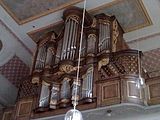
|
II / P | 15th | Expanded in 1940 |
| 1784 | Nieder-Flörsheim | Ev. church | I / P | 16 | 1965 restoration by Oberlinger, 2007 by Förster & Nicolaus | |
| 1785 | Haardt on the Wine Route | Ev. church | I / P | 16 | largely preserved | |
| 1785 | Hamlet (near Mayen) | St. Castor | I / P | 1876 extension conversion by Dasbach (II / P / 23) | ||
| 1785-1786 | Mother city | Ev. Parish church | II / P | 22nd | Michael II and Franz Stumm. Looted during the French Revolution; 1804 renewal by Stumm (II / P / 24); 1866–1868 reconstruction by Schlimbach (II / P / 21); 1971 restoration by Oberlinger and 2006 by Förster & Nicolaus | |
| 1786 | Mörstadt | Village church | I / P | 15th | 1996 restoration by Förster & Nicolaus | |
| 1785-1788 | Neckargemünd | Ulrich Church | II / P | 27 | Conversions and electrification by Steinmeyer, 1996 restoration / reconstruction by Peter Vier , Friesenheim | |
| 1786-1788 | Schriesheim | Ev. City Church | II / P | 21st | 1977 new building in Weigle, 2014 reorganization / partial new building Jäger & Brommer; Prospectus received | |
| 1787-1788 | Flörsheim-Dalsheim | Catholic Church | I / P | 15th | Attribution; 1878 and 1903 alterations by H. Bechstein; 1981 restoration by Förster & Nicolaus; about half of the registers preserved | |
| 1790 | Spiesheim | St. Stephen | I / P | 10 | underplayed work | |
| 1790-1791 | Dreieichenhain | Castle Church | I / P | 15th | Philipp and Franz Stumm; Modifications in 1911 by Bechstein and in 1952 by Förster & Nicolaus, who carried out a restoration from 1973–1975 | |
| 1790-1791 | Selzen | Ev. Parish church | I / P | 17th | Donated by the local resident Jacob Waadt. Treaty of 1787 has been preserved. Completed in 1791 by Philipp and Franz Stumm. The impending confiscation of the prospect pipes could be avoided in 1917 by delivering the reed pipes and various labial pipes from the interior. 1974 Restoration by Gerhard Schmid, missing individual pipes and missing complete registers reconstructed. 2015 restoration and reconstruction of three wedge bellows by Klais; largely preserved. After Framersheim it is the second largest single-manual Stumm organ. | |
| 1792 | Worms-Pfeddersheim | Simultankirche (catholic part) | I / P | 14th | 1998 restoration by Förster & Nicolaus; 13 registers preserved | |
| 1788-1793 | Zell (Moselle) | St. Peter | II / P | 26th | Rearranged in the 19th century; 1944 renovation by Sebald and Brand (III / P / 32); Prospectus received | |
| 1791-1793 | Bacharach | St. Peter | I / p | 9 | 1826 extension conversion by Stumm using 4 registers; In 1878 and 1905 further modifications by Stumm; 1974/75 restoration to the original disposition from 1826 (II / P / 26); largely preserved | |
| 1796 | Altweidelbach | Ev. church | I / P | 10 | 1956 modernization, 1989 restoration by Oberlinger | |
| around 1800 | Ediger | St. Martin | II / P | 19th | Only reached Ediger in 1826; 1984 restoration by Oberlinger; largely preserved | |
| 1802 | Kronberg im Taunus | City Church of St. Johann |

|
II / P | 27 | In 1845 Felix Mendelssohn Bartholdy played the Kronberg organ. 1897 replaced by Walcker and 1966 replaced by a new building in the old housing by Hillebrand , Hanover (III / P / 32) |
| 1802 | Steeg | Ev. St. Anna Church | II / P | 23 | 2005/2006 by Rainer Müller, Merxheim, restored and reconstructed in the original "Cornett tone" | |
| 1806 | Offenheim | Ev. church | I / P | 13 | Friedrich Carl Stumm; 1902 rearrangement by H. Bechstein; 1985 Partial restoration by Förster & Nicolaus; 2015–2016 restoration by Rainer Müller. Curiously, the organ did not have a sub-bass 16 ′ in the pedal, but instead two open 8 ′ registers with the octave bass 8 ′ and violon bass 8 ′ registers. | |
| 1804-1807 | Michelstadt | Michelstadt town church |
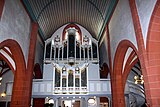
|
II / P | 26th | Was replaced by a Steinmeyer organ in 1910 (III / P / 31). For cost reasons, the case of the Stumm organ was preserved and reused. |
| 1809 | Kleinich | Protestant church | I / P | 15th | 1986 restoration by Klais; Almost completely preserved → Organ of the Evangelical Church in Kleinich | |
| 1813 | Oiling | Ev. church | I / P | 10 | Franz Stumm; largely preserved |
Fourth generation
Representatives of the fourth generation were the two second cousins, who again concentrated their field of activity on the left bank of the Rhine on the Palatinate and the Taunus. The following representatives ran the company from around 1813 to 1845:
- Carl (Philipp) Stumm (born August 17, 1783; † November 23, 1845 in Sulzbach), son of Philipp
- Franz Heinrich Stumm (born August 8, 1788; † January 26, 1859 in Sulzbach), son of Friedrich Carl
stylistics
The organ cases (prospectuses) remain largely from the late Baroque era . Only a few classicist housings are known (e.g. in Treis). In terms of sound, the organs tend towards romanticism .
List of works
| year | place | building | image | Manuals | register | Remarks |
|---|---|---|---|---|---|---|
| 1815 | Pünderich | Assumption Day | II / P | 21st | Modifications in 1879 (Voltmann, Klausen) and 1959 (Elsen, Wittlich), 1976 restoration by Oberlinger | |
| 1818 | Wonsheim | Lambertus Church | I / P | 14th | largely preserved including the prospectus pipes | |
| 1818-1820 | Sankt Goar | Collegiate church | II / P | 23 | Franz Heinrich and Carl Stumm; Implementation in 1842, later minor rescheduling; 1954–1956 extension conversion by Willi Peter; 1974 restoration; 1995 general overhaul; 5 registers completely and 2 partially preserved | |
| 1820 or 1790s | Meckenbach (near Kirn) | Ev. church | I / P | 14th | Attribution; 1948 repair by Oberlinger, exchange of a register; 1981 or 1983 restoration by Klais | |
| 1820 | Koblenz | Florin's Church | Destroyed in a smoldering fire in 1970 | |||
| 1824 | Blieskastel | Castle Church | 1905 completely unusable by a new organ of the Bavarian company GF Steinmeyer & Co. replaced | |||
| 1828 | Ediger-Eller | St. Hilary | I / P | 13 | Later rescheduling; 1979 restoration by Oberlinger | |
| 1828 | Bishop's throne | St. Paulin | II / P | 19th | 1975 Restoration by Gerhard & Sons | |
| 1831 | Niederhorbach | Ev. church | I / P | 11 | Identical to Kapellen-Drusweiler; 1997 restoration by Förster & Nicolaus; largely preserved | |
| 1831 | Kapellen-Drusweiler | Ev. church | I / P | 11 | Identical to Niederhorbach | |
| 1832 | Allenbach | Ev. church | I / P | 12 | 1965/66 restoration by Oberlinger and expansion by 2 registers | |
| 1833 | Alsenborn | Protestant Church | Carl and Franz Heinrich Stumm; identical to Enkenbach; The case is decorated with classicist carvings; 2007 restoration by Förster & Nicolaus | |||
| 1833 | Enkenbach | Monastery church | Carl and Franz Heinrich Stumm; identical to Alsenborn; 1900 remodeling; 1964 restoration; largely preserved | |||
| 1833 | Bruchweiler | Ev. church | I / P | 11 | Classicist prospectus | |
| 1834 | Schweinschied Baumholder since 2003 | Ev. Church until 1963, then the church was rebuilt and the organ "too large" was dismantled and replaced with a small organ from Hermann Eule Orgelbau Bautzen | I / P | 11 | After several sales and storage in 2001, it was taken over by the ev. Baumholder parish , restoration according to the original design by Orgelbau Müller , Merxheim , new construction of the prospectus in Stumm's style with additional installation of a pedal beam system (for different wind pressure) and commissioning in July 2003 | |
| 1834 | Wolfersweiler | Ev. church | I / P | 15th | 1968 restoration by Oberlinger according to the state of knowledge at the time; largely preserved, three registers replaced | |
| 1836 | Treis cards | St. John the Baptist | II / P | 29 | Carl and Franz Stumm; 1963 unfortunate restoration by Helmut Seifert, 2013 renovation by the Klais company in 2013 and restoration of the old color version | |
| 1837 | Siesbach | Ev. church | I / P | 11 | 1889 renovation by Gustav Stumm; 1992 restoration by Förster & Nicolaus | |
| 1838 | Quiet | Ev. Parish church of Heiligenbösch | I / P | 12 | Side play; Restoration by Oberlinger in 1977 and by G. Cartellieri in 1988 | |
| 1838 | Ommersheim | Visitation of the Virgin Mary |

|
I / P | Modifications in 1896 by JHW Huber and in 1950 and 1970 by Lothar Hintz; received some registers | |
| 1840 | Trittenheim | St. Clement | II / P | 19th | Franz Heinrich and Carl Stumm; not received | |
| 1841 | Track cells | Ev. church | I / P | 11 | 1997 restoration by Förster & Nicolaus; largely preserved | |
| 1841 | Then after | St. Peter | II / P | 14th | Originally built for the St. Nikolaus Hospital Chapel, expanded there in 1962 and installed in St. Peter and Paul in Urmitz-Bahnhof at the end of the 1970s ; 1992 Restoration by Förster & Nicolaus and transfer to St. Peter in Andernach | |
| 1839-1842 | Geisenheim | Rheingau Cathedral | II / P | 33 | Largest two-manual silent organ from the 19th century; 17 complete registers and 5 partially preserved | |
| 1843 | Contwig | Martin Luther Church | I / P | 13 | 2005 restoration by Förster & Nicolaus; 9 registers preserved | |
| 1843 | Catfish catch | former Augustinian monastery church of St. Katharina | I / P | 12 | Sold to Lisdorf in 1861 , enlarged by Dalstein & Haerpfer in 1905, sold to Piesbach in 1943 ; not received | |
| 1845 | Pomerania (Moselle) | St. Stephan | II / P | 18th | Rearranged in 1875 and 1898, restored by Klais in 1979 | |
| 1844-1846 | Hennweiler | Ev. church | I / P | 15th | Two contracts with Johann Michael Stumm II from 1790 and 1792 were probably not carried out, instead an existing organ was extended by a second manual; 1969 Extension conversion by Oberlinger to II / P / 22 with unconventionally designed substation in the new parapet above the pulpit; no pipe material before 1846 | |
| 1846 | Bad Schwalbach | Luther Church |
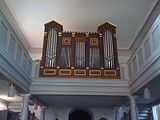
|
I / P | 12 | Originally built for Pleisberg, restored and transferred in 1992 |
| 1847 | Ulmet | Protest. church | I / P | 14th | the same housing as Altenkirchen (1844, replaced in 1954); largely preserved |
Fifth generation
Representatives were the brothers:
- Friedrich Carl Stumm (born December 6, 1819 - † November 26, 1891 in Sulzbach), son of Franz Heinrich
- Georg Karl Ernst Stumm (born May 31, 1824 in Sulzbach; † July 8, 1869 in Kirn), son of Franz Heinrich
stylistics
The timbres of the fifth generation are generally kept more fundamental. The competition is getting stronger and the organs are mostly designed with only one manual. It was during this time that the conventional silent prospectuses were abandoned and designed in the style of historicism . The casings are mostly neo-Romanesque or neo-Gothic in the style of the time .
List of works
| year | place | building | image | Ma nu ale |
Reg. | Remarks |
|---|---|---|---|---|---|---|
| 1851 | Hambuch | St. John | II / P | 22nd | Largely preserved | |
| 1852 | Bubach | Ev. church | I / P | 10 | Side-playing, classicist-neo-Romanesque prospectus with three round arches without carving; In 1904 a register was exchanged by Gustav Stumm, which was reversed in 1970 during restoration by Oberlinger | |
| 1852 | Schmidthachenbach | Ev. church | I / P | 13 | Op. 2; 1979 restoration by G. Cartellieri; largely preserved | |
| 1853 | Bulging | St. Laurence | II / P | 19th | 2 reeds have been lost; 1997 restoration by Förster & Nicolaus | |
| 1857 | Ludweiler | Huguenot Church | I / P | 9 | Prospectus with three round arches without carving; 1957 extensive reconstruction by Oberlinger; 1998 restoration by Rainer Müller; today II / P / 22 | |
| 1861 | Stipshausen | Ev. church | I / P | 10 | 1955 moved to the west gallery and the prospectus replaced; 1986 new prospectus with a central round tower flanked by two harp fields, not a copy of the original; Most of the pipework has been preserved | |
| 1863 | Grumbach (Kusel district) | Ev. church | 1917 Sale of prospect pipes for armament purposes; otherwise completely preserved; 1993–1996 restoration by Rainer Müller | |||
| 1865 | Glan-Münchweiler | Protest. church | I / P | 11 | Rebuilt in 1967 by Oberlinger; largely preserved | |
| 1866 | Oberheimbach | St. Margarita | II / P | 16 | Prospectus with pointed arch fields; op. 36 | |
| 1869 | Bickenbach (Hunsrück) | St. Stephan | II / P | 16 | 1983 restoration by Vleugels | |
| 1870 | Herschberg | Protest. church | I / P | 12 | The last Stumm organ with slider drawer, the work also delivered to Niederbexbach in 1870 already has a cone drawer; almost completely preserved. | |
| 1871 | Konken | Prot. Church | I / P | 13 | 2010 restoration by Förster & Nicolaus | |
| 1872 | Remagen | Ev. church |
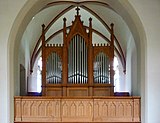
|
I / P | 12 | since 1905 in Bad Breisig , Christ Church; possibly a new, neo-Gothic front on this move |
| 1873 | Oberhausen on the Nahe | Protest. church | I / P | 10 | largely preserved. | |
| 1876 | Feilbingert | St. Michael | I / P | 10 | 1990 new building by Gerhard Kuhn (II / P / 16); Received from mute housing and 8 registers. | |
| 1877 | Luxembourg City | Trinity Church |

|
II / P | 18th | Later rescheduling; 1998/99 restoration to old condition by Oberlinger (currently II / P / 22) |
| 1877 | Thalfang | Ev. church | I / P | 11 | Cone chest, free pipe prospectus; op. 60; 1977 restoration by Gustav Cartellieri | |
| 1881 | Saint Julian | Ev. church | II / P | 14th | Largely preserved | |
| 1882 | Lousy | Ev. church | I / P | 13 | 1951 extensive reconstruction by Oberlinger; 2007/08 restoration by Richard Franz, based on the original concept; Half of the registers received, two more silent registers bought from the northern Palatinate and integrated |
Sixth generation
The sixth generation is shaped by the upheavals of time. In 1896 the company in Sulzbach was closed. Stylistic accents could no longer be set. From around 1870 cone shops are built.
Representatives are the brothers:
- Friedrich Stumm (1846–1921), son of Friedrich Carl (II.)
- Karl (II.) Stumm (1847–1926), son of Friedrich Carl (II.)
List of works
| year | place | building | image | Manuals | register | Remarks |
|---|---|---|---|---|---|---|
| 1886 | Niederlinxweiler | Ev. church | Friedrich and Karl Stumm | |||
| 1887 | Reichenbach | Protest. church | I / P | 9 | Rebuilt in 1960 by Oberlinger; largely preserved | |
| 1888 | Veldenz | Ev. church | I / P | 12 | Cone drawer, free-standing gaming table | |
| 1890 | Mülheim (Moselle) | Protestant church | I / P | 9 | Cone drawer, prospectus with neo-Romanesque round arches | |
| 1891 | Niedermoschel | Protest. church | I / P | 10 | largely preserved | |
| 1891-1892 | Upper cost | Ev. church | I / P | 11 | Cone drawer | |
| 1895 | Mörschied | Ev. church | I / P | 7th | 1988 Restoration by Förster & Nicolaus | |
| 1895 | Hackenheim | ev. church (former simultaneous church) | I / P | 13 | Mechanical cone shop, factory stored today, restoration planned | |
| 1895 | Norheim | Exaltation of the Cross | I / P | 14th | Mechanical cone shop, sound reconstruction by Gebr. Oberlinger in the 1960s | |
| 1896 | Niederhosenbach | Ev. church | I / P | 7th | Last work by Stumm; mechanical slide box; 1993/94 restoration by Schuke, Potsdam to its original condition including bellows |
Seventh generation
Georg Karl Ernst (fifth generation) had two sons who settled in Emmerich, as the company was taken over by the sons of Friedrich Carl (II.). After Julius' early death, Gustav moved his workshop to Kirn . Mainly organs with mechanical and occasionally pneumatic action were built here. With the death of Gustav in 1906 this company was closed. Parts of the workshop were bought from the heirs of the neighboring family of organ builders, Gebrüder Oberlinger in Windesheim . The Oberlinger company continues the tradition of the Hunsrück organ builders. From the organs of the seventh Stumm generation, around 20 works have survived.
Representative:
- Gustav Stumm (1855–1906), son of Georg Karl Ernst
- Julius Stumm (1858–1885), son of Georg Karl Ernst
List of works
| year | place | building | image | Manuals | register | Remarks |
|---|---|---|---|---|---|---|
| 1886 | Sargenroth | Nunkirche | II / P | 12 | Brochure with three arched fields, cone drawer, free-standing gaming table | |
| 1893 | Rhaunen | St. Martin |

|
I / P | 12 | Cone drawer, mech. Action |
| 1893 | Niederbrombach | Protestant church | I / P | 10 | Replaced in 1966 by an organ by W. Bosch | |
| 1895 | Mörschied | Ev. church | I / P | 8th | Cone drawer, mech. Action; 1950s relocation by Oberlinger; 1988/2005 restoration by Förster & Nicolaus | |
| 1906 | Traisen (near) | Ev. church | I / P | 6th | For 1958 marks; Replaced in 1976 by Oberlinger, housing preserved | |
| 1907 | Konz-Karthaus | Protestant church | ? | ? | Of the costs of 4,068 marks, 1,000 marks were paid on delivery and the remainder of the purchase price until 1908 from grants from the Consistory and the collection fund. The missing organ was removed in 1966 as part of the church renovation. |
literature
- Franz Bösken : The Stumm family of organ builders from Rhaunen-Sulzbach and their work. A contribution to the history of organ building on the Middle Rhine . Mainzer Altertumsverein, Mainz 1981 (special print from Mainz magazine vol. 55, 1960).
- Franz Bösken: Stumm, family organ builders . In: Music in the past and present . 1st edition. tape 12 . Bärenreiter, Kassel 1965, ISBN 3-89853-160-0 , p. 1639 f (CD-ROM edition of the 1st edition, Directmedia, Berlin 2003).
- Franz Bösken: Sources and research on the organ history of the Middle Rhine (= contributions to the Middle Rhine music history . Volume 6 ). tape 1 : Mainz and suburbs - Rheinhessen - Worms and suburbs . Schott, Mainz 1967, ISBN 978-3-7957-1306-5 .
- Franz Bösken: Sources and research on the organ history of the Middle Rhine. Vol. 2: The area of the former administrative district of Wiesbaden (= contributions to the music history of the Middle Rhine . Volume 7.1 ). Part 1: A-K . Schott, Mainz 1975, ISBN 3-7957-1307-2 .
- Franz Bösken: Sources and research on the organ history of the Middle Rhine. Vol. 2: The area of the former administrative district of Wiesbaden (= contributions to the music history of the Middle Rhine . Volume 7.2 ). Part 2: L-Z . Schott, Mainz 1975, ISBN 3-7957-1370-6 .
- Franz Bösken, Hermann Fischer, Matthias Thömmes: Sources and research on the organ history of the Middle Rhine. Vol. 4: Koblenz and Trier administrative districts, Altenkirchen and Neuwied districts (= contributions to the history of music in the Middle Rhine region . Volume 40 ). 2 volumes. Schott, Mainz 2005, ISBN 978-3-7957-1342-3 .
- Bernhard H. Bonkhoff: Monument organs in the Palatinate . Evangelischer Presseverlag Pfalz, Speyer 1990, ISBN 3-925536-27-2 .
- Hermann Brucker: The Stumm family of organ builders from Hunsrück. In: Hunsrücker Heimatblätter. No. 25, 1971, pp. 517-521.
- Friedrich W. Riedel: The Stumm family and organ building. The organ landscape of the Rhine . In: Before times. History in Rhineland-Palatinate . tape 5 . Mainz 1989, p. 111-130 .
- Hans-Wolfgang Theobald : The workshop Stumm in Rhaunen / Sulzbach. In: Friedrich Wilhelm Riedel (ed.): The organ as a sacred work of art. Vol. 1. Verlag des Bischöflichen Stuhles, Mainz 1992, pp. 204–233.
Web links
- Stumm-Orgelverein Rhaunen-Sulzbach eV www.stumm-orgelverein.de
- The Stumm family in the Rheinische Geschichte portal
- Trier organ point: the organ building dynasty Stumm
- Stumm-Orgeln vg-rhaunen.de
Individual evidence
- ↑ a b Trier Orgelpunkt: The Stumm organ-building dynasty , accessed on May 17, 2019.
- ↑ Ev. Nieder-Wiesen Church , accessed on May 16, 2019.
- ^ Bösken: Stumm, family of organ builders. 1965, p. 1639 f.
- ↑ a b c Bösken: Stumm, family of organ builders. 1965/1981, p. 54 f.
- ↑ a b Anneliese Bösken (ed.), Hermann Fischer , and Matthias Thömmes (. Ed): sources and research on organ history of the middle Rhine ., Vol 4: administrative districts Koblenz and Trier, circles old churches and Neuwied , subband 2: Ma - Z . Schott, Mainz 2005, ISBN 3-7957-1342-0 , p. 31.
- ↑ a b Anneliese Bösken (ed.), Hermann Fischer, and Matthias Thömmes (. Ed): sources and research on organ history of the middle Rhine ., Vol 4: administrative districts Koblenz and Trier, circles old churches and Neuwied , subband 2: Ma - Z . Schott, Mainz 2005, p. 29.
- ^ Bösken, Fischer, Thömmes: Sources and research on the organ history of the Middle Rhine. Vol. 4. 2005, pp. 478-482.
- ^ Bösken, Fischer, Thömmes: Sources and research on the organ history of the Middle Rhine. Vol. 4. 2005, pp. 709 f.
- ^ Bösken, Fischer, Thömmes: Sources and research on the organ history of the Middle Rhine. Vol. 4. 2005, p. 894 f.
- ^ Bösken, Fischer, Thömmes: Sources and research on the organ history of the Middle Rhine. Vol. 4. 2005, p. 1199 f.
- ^ Bösken: Sources and research on the organ history of the Middle Rhine. Vol. 1. 1967, p. 400 f.
- ^ Bösken, Fischer, Thömmes: Sources and research on the organ history of the Middle Rhine. Vol. 4. 2005, pp. 452-456.
- ^ Bösken, Fischer, Thömmes: Sources and research on the organ history of the Middle Rhine. Vol. 4. 2005, p. 526 f.
- ^ Bösken, Fischer, Thömmes: Sources and research on the organ history of the Middle Rhine. Vol. 4. 2005, p. 1016 f.
- ^ Bösken, Fischer, Thömmes: Sources and research on the organ history of the Middle Rhine. Vol. 4. 2005, p. 417 f.
- ^ Organ in Alzey , accessed on May 16, 2019.
- ^ Bösken, Fischer, Thömmes: Sources and research on the organ history of the Middle Rhine. Vol. 4. 2005, p. 615 f.
- ^ Bösken, Fischer, Thömmes: Sources and research on the organ history of the Middle Rhine. Vol. 4. 2005, pp. 912-914.
- ^ Bösken, Fischer, Thömmes: Sources and research on the organ history of the Middle Rhine. Vol. 4. 2005, p. 980 f.
- ^ Bösken, Fischer, Thömmes: Sources and research on the organ history of the Middle Rhine. Vol. 4. 2005, p. 986 f.
- ^ Bösken, Fischer, Thömmes: Sources and research on the organ history of the Middle Rhine. Vol. 4. 2005, p. 1186 f.
- ^ Bösken, Fischer, Thömmes: Sources and research on the organ history of the Middle Rhine. Vol. 4. 2005, p. 635.
- ↑ Bonkhoff: historic organs in the Palatinate. 1990, p. 60.
- ^ Organ of the Paulskirche Kirchheimbolanden , accessed on May 16, 2019.
- ^ Bösken, Fischer, Thömmes: Sources and research on the organ history of the Middle Rhine. Vol. 4. 2005, p. 1008 f.
- ↑ a b c d e Bösken, Fischer, Thömmes: Sources and research on the organ history of the Middle Rhine. Vol. 4. 2005, p. 30.
- ↑ Lahnstein City Archives OL139 / 5, pages 50–54
- ^ Bösken: Sources and research on the organ history of the Middle Rhine . Vol. 2, Part 2: L – Z. 1975, p. 684 f.
- ^ Bösken: Sources and research on the organ history of the Middle Rhine. Vol. 1. 1967, p. 286 f.
- ^ Organ in Koblenz-Horchheim , accessed on May 16, 2019.
- ^ Bösken, Fischer, Thömmes: Sources and research on the organ history of the Middle Rhine. Vol. 4. 2005, pp. 1018-1020.
- ^ Organ in Heimersheim , accessed on May 16, 2019.
- ^ Bösken, Fischer, Thömmes: Sources and research on the organ history of the Middle Rhine. Vol. 4. 2005, pp. 879 f.
- ^ Bösken, Fischer, Thömmes: Sources and research on the organ history of the Middle Rhine. Vol. 4. 2005, p. 974.
- ^ Bösken: Sources and research on the organ history of the Middle Rhine. Vol. 1. 1967, p. 364 f.
- ^ Bösken: Sources and research on the organ history of the Middle Rhine. Vol. 1. 1967, pp. 420-422.
- ^ Bösken: Sources and research on the organ history of the Middle Rhine. Vol. 1. 1967, pp. 249-251.
- ^ Bösken, Fischer, Thömmes: Sources and research on the organ history of the Middle Rhine. Vol. 4. 2005, p. 1149 f .; Organ in Trier, Welschnonnen Church , accessed on May 16, 2019.
- ^ Organ in Durlach , accessed on May 16, 2019.
- ^ Bösken: Sources and research on the organ history of the Middle Rhine. Vol. 1. 1967, p. 464 f.
- ^ Bösken, Fischer, Thömmes: Sources and research on the organ history of the Middle Rhine. Vol. 4. 2005, pp. 302-304.
- ^ Bösken: Sources and research on the organ history of the Middle Rhine. Vol. 1. 1967, p. 381 f.
- ^ Bösken: Sources and research on the organ history of the Middle Rhine. Vol. 1. 1967, p. 263.
- ^ Bösken, Fischer, Thömmes: Sources and research on the organ history of the Middle Rhine. Vol. 4. 2005, p. 665 f.
- ^ Bösken, Fischer, Thömmes: Sources and research on the organ history of the Middle Rhine. Vol. 4. 2005, pp. 916-918.
- ^ Organ in Rheinberg , accessed on May 16, 2019.
- ^ Bösken: Sources and research on the organ history of the Middle Rhine. Vol. 1. 1967, p. 52.
- ^ Organ in Bärstadt , accessed on May 16, 2019.
- ^ Bösken, Fischer, Thömmes: Sources and research on the organ history of the Middle Rhine. Vol. 4. 2005, pp. 402-404; Organ in Hillesheim , accessed on May 16, 2019.
- ^ Organ in Gau-Odernheim , accessed on May 16, 2019.
- ^ Bösken: Sources and research on the organ history of the Middle Rhine. Vol. 1. 1967, p. 52.
- ↑ organindex.de: Saarbrücken, Ludwigskirche , accessed on May 16, 2019.
- ^ Bösken: Sources and research on the organ history of the Middle Rhine. Vol. 1. 1967, p. 302.
- ^ Bösken, Fischer, Thömmes: Sources and research on the organ history of the Middle Rhine. Vol. 4. 2005, pp. 435-437.
- ^ Bösken, Fischer, Thömmes: Sources and research on the organ history of the Middle Rhine. Vol. 4. 2005, p. 170 f.
- ^ Bösken, Fischer, Thömmes: Sources and research on the organ history of the Middle Rhine. Vol. 4. 2005, p. 950 f.
- ↑ The organ in the former Amorbach Abbey Church , accessed on May 16, 2019.
- ^ Bösken, Fischer, Thömmes: Sources and research on the organ history of the Middle Rhine. Vol. 4. 2005, p. 972 f.
- ^ Bösken: Sources and research on the organ history of the Middle Rhine. Vol 2, part. 2: L-Z . 1975, p. 757.
- ^ Bösken, Fischer, Thömmes: Sources and research on the organ history of the Middle Rhine. Vol. 4. 2005, p. 397.
- ^ Organ in Gensingen , accessed on May 16, 2019.
- ^ Bösken: Sources and research on the organ history of the Middle Rhine. Vol. 2, Part 1: A – K. 1975, p. 412 f.
- ↑ www.orgelbau-klais.com: St. Wendel , accessed on May 16, 2019 (PDF file; 201 kB).
- ^ Organ in St. Wendel , accessed on May 16, 2019.
- ^ Bösken: Sources and research on the organ history of the Middle Rhine. Vol. 2, Part 1: A – K. 1975, p. 106 f.
- ^ Bösken: Sources and research on the organ history of the Middle Rhine. Vol. 2, Part 1: A – K. 1975, p. 106 f.
- ^ Bösken: Sources and research on the organ history of the Middle Rhine. Vol. 1. 1967, p. 392 f.
- ^ Bösken, Fischer, Thömmes: Sources and research on the organ history of the Middle Rhine. Vol. 4. 2005, p. 1201.
- ↑ The Stumm-Organ of the Protestant Church in Mutterstadt , accessed on May 16, 2019 (PDF file; 1.7 MB).
- ^ Bösken: Sources and research on the organ history of the Middle Rhine. Vol. 1. 1967, p. 263.
- ^ Hans Martin Balz: organs and organ builders in the area of the former Hessian province of Starkenburg. Bärenreiter-Antiquariat, Kassel 1969, p. 515.
- ^ Organ in Pfeddersheim , accessed on May 16, 2019.
- ^ Bösken, Fischer, Thömmes: Sources and research on the organ history of the Middle Rhine. Vol. 4. 2005, p. 1250 f.
- ^ Bösken, Fischer, Thömmes: Sources and research on the organ history of the Middle Rhine. Vol. 4. 2005, pp. 116-120.
- ^ Bösken, Fischer, Thömmes: Sources and research on the organ history of the Middle Rhine. Vol. 4. 2005, p. 82.
- ^ Bösken, Fischer, Thömmes: Sources and research on the organ history of the Middle Rhine. Vol. 4. 2005, p. 286 f.
- ^ Bösken: The organ builder family Stumm from Rhaunen-Sulzbach and their work. 1981, p. 76.
- ^ Bösken: Sources and research on the organ history of the Middle Rhine. Vol. 2, Part 1: A – K. 1975, pp. 528-530.
- ↑ Organ in Steeg , accessed on May 16, 2019.
- ^ Organ in Offenheim , accessed on May 16, 2019.
- ^ Hans Martin Balz: organs and organ builders in the area of the former Hessian province of Starkenburg. Bärenreiter-Antiquariat, Kassel 1969, p. 554 f.
- ^ Bösken, Fischer, Thömmes: Sources and research on the organ history of the Middle Rhine. Vol. 4. 2005, p. 502.
- ^ Organ in Pünderich , accessed on May 16, 2019.
- ^ Bösken, Fischer, Thömmes: Sources and research on the organ history of the Middle Rhine. Vol. 4. 2005, pp. 939-941.
- ^ Bösken, Fischer, Thömmes: Sources and research on the organ history of the Middle Rhine. Vol. 4. 2005, p. 661 f.
- ^ Bösken, Fischer, Thömmes: Sources and research on the organ history of the Middle Rhine. Vol. 4. 2005, p. 524.
- ↑ Herbert Hch. Bölke: Blieskastel Castle Church , 2nd edition. Blieskastel 2013, p. 9.
- ^ Bösken, Fischer, Thömmes: Sources and research on the organ history of the Middle Rhine. Vol. 4. 2005, p. 293 f.
- ^ Bösken, Fischer, Thömmes: Sources and research on the organ history of the Middle Rhine. Vol. 4. 2005, p. 198.
- ↑ a b Organ in Niederhorbach , accessed on May 16, 2019.
- ^ Bösken, Fischer, Thömmes: Sources and research on the organ history of the Middle Rhine. Vol. 4. 2005, p. 74.
- ^ Organ in Bruchweiler , accessed on May 16, 2019.
- ^ Elisabeth Jost: Organ in Baumholder , accessed on May 16, 2019.
- ^ Organ in Wolfersweiler , accessed on May 16, 2019.
- ^ Bösken, Fischer, Thömmes: Sources and research on the organ history of the Middle Rhine. Vol. 4. 2005, p. 1024 f .; Organ in Treis-Karden, St. Johannes , accessed on May 16, 2019.
- ^ Bösken, Fischer, Thömmes: Sources and research on the organ history of the Middle Rhine. Vol. 4. 2005, p. 972.
- ^ Bösken, Fischer, Thömmes: Sources and research on the organ history of the Middle Rhine. Vol. 4. 2005, p. 379 f.
- ↑ Bonkhoff: historic organs in the Palatinate. 1990, p. 150.
- ^ Bösken, Fischer, Thömmes: Sources and research on the organ history of the Middle Rhine. Vol. 4. 2005, p. 1153.
- ^ Organ in track cells , accessed on May 16, 2019.
- ^ Bösken, Fischer, Thömmes: Sources and research on the organ history of the Middle Rhine. Vol. 4. 2005, p. 97.
- ^ Organ in Geisenheim , accessed on May 16, 2019.
- ^ Organ in Contwig , accessed on May 16, 2019.
- ↑ Bernhard H. Bonkhoff: Historical Organs in Saarland. Schnell & Steiner, Regensburg 2015, p. 114.
- ^ Bösken, Fischer, Thömmes: Sources and research on the organ history of the Middle Rhine. Vol. 4. 2005, pp. 386-390.
- ^ Organ in Bad Schwalbach , accessed on May 16, 2019.
- ↑ Bonkhoff: historic organs in the Palatinate. 1990, p. 174.
- ^ Bösken, Fischer, Thömmes: Sources and research on the organ history of the Middle Rhine. Vol. 4. 2005, p. 234.
- ^ Bösken, Fischer, Thömmes: Sources and research on the organ history of the Middle Rhine. Vol. 4. 2005, p. 953.
- ^ Organ in Beulich , accessed on May 16, 2019.
- ^ Organ in Ludweiler , accessed on May 16, 2019.
- ^ Bösken, Fischer, Thömmes: Sources and research on the organ history of the Middle Rhine. Vol. 4. 2005, p. 998 f.
- ^ Organ in Grumbach , accessed on May 16, 2019.
- ↑ Bonkhoff: historic organs in the Palatinate. 1990, p. 200.
- ^ Bösken, Fischer, Thömmes: Sources and research on the organ history of the Middle Rhine. Vol. 4. 2005, p. 796.
- ^ Bösken, Fischer, Thömmes: Sources and research on the organ history of the Middle Rhine. Vol. 4. 2005, p. 186 f.
- ↑ Bonkhoff: historic organs in the Palatinate. 1990, p. 228.
- ↑ Bonkhoff: historic organs in the Palatinate. 1990, p. 232.
- ↑ Bonkhoff: historic organs in the Palatinate. 1990, p. 244.
- ^ Bösken, Fischer, Thömmes: Sources and research on the organ history of the Middle Rhine. Vol. 4. 2005, p. 1012 f.
- ↑ Organ in Miesau , accessed on May 16, 2019 (PDF file; 202 kB).
- ↑ Bonkhoff: historic organs in the Palatinate. 1990, p. 276.
- ^ Bösken, Fischer, Thömmes: Sources and research on the organ history of the Middle Rhine. Vol. 4. 2005, p. 1176.
- ^ Bösken, Fischer, Thömmes: Sources and research on the organ history of the Middle Rhine. Vol. 4. 2005, p. 698 f.
- ↑ Bonkhoff: historic organs in the Palatinate. 1990, p. 286.
- ^ Bösken, Fischer, Thömmes: Sources and research on the organ history of the Middle Rhine. Vol. 4. 2005, p. 799.
- ^ Bösken, Fischer, Thömmes: Sources and research on the organ history of the Middle Rhine. Vol. 4. 2005, p. 783.
- ^ Bösken, Fischer, Thömmes: Sources and research on the organ history of the Middle Rhine. Vol. 4. 2005, p. 765 f.
- ^ Bösken, Fischer, Thömmes: Sources and research on the organ history of the Middle Rhine. Vol. 4. 2005, p. 948 f.
- ^ Organ in Sargenroth , accessed on May 16, 2019.
- ^ Bösken, Fischer, Thömmes: Sources and research on the organ history of the Middle Rhine. Vol. 4. 2005, p. 896.
- ^ Bösken, Fischer, Thömmes: Sources and research on the organ history of the Middle Rhine. Vol. 4. 2005, p. 753.
- ^ Organ in Mörschied , accessed on May 16, 2019.
- ^ Bösken, Fischer, Thömmes: Sources and research on the organ history of the Middle Rhine. Vol. 4. 2005, p. 1022.
- ↑ Ferdinand Kläs, Wolfgang Wallrich: Chronicle, 100 Years of Evangelical Christians in Conc. 1980, pp. 100 and 197 f.








